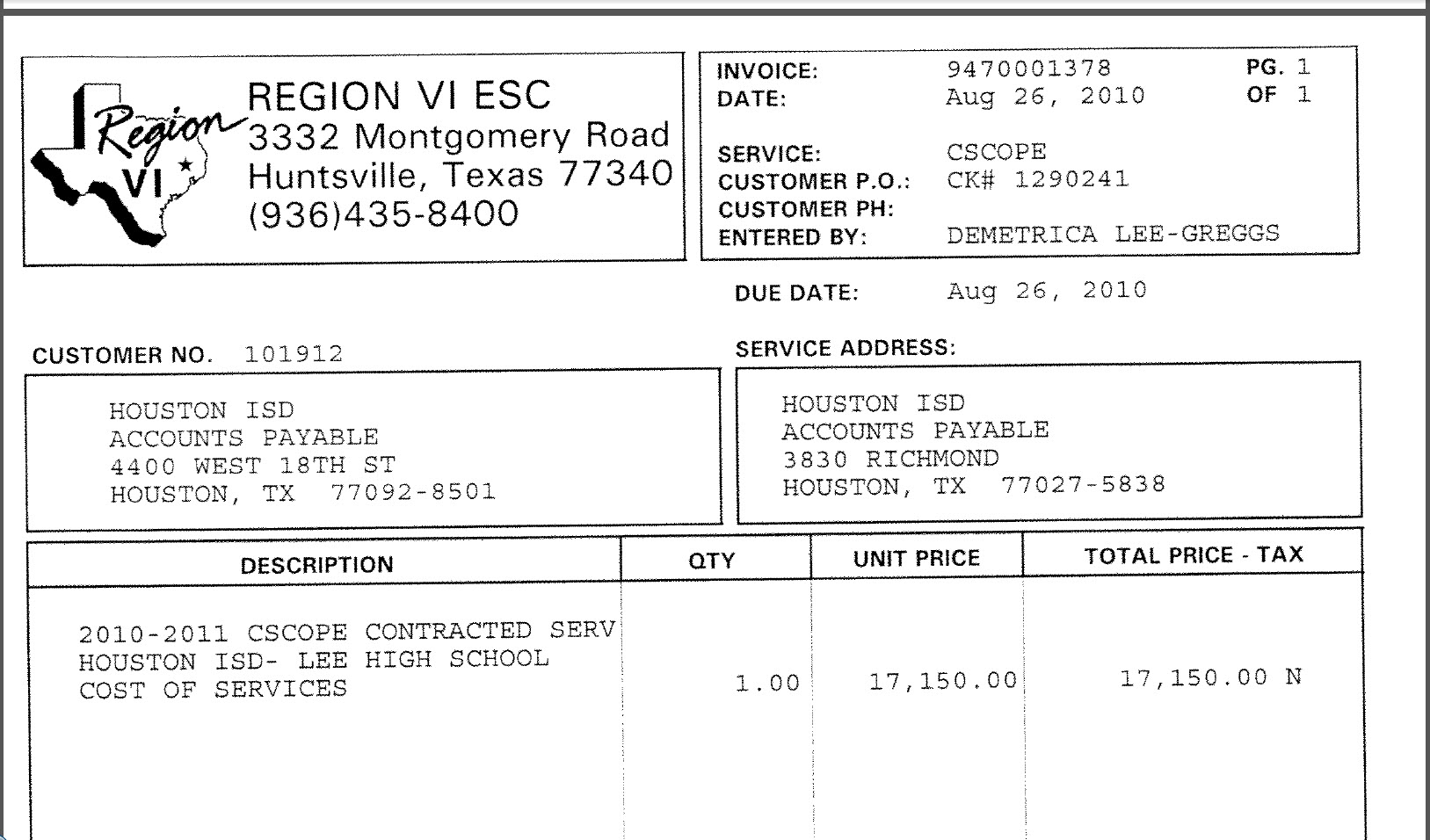
http://www.educationviews.org/houston-isd-sells-soul-30-silver-coins/
“Houston ISD Sells Its Soul for 30 Silver Coins”
by Henry W. Burke
2.26.14
Judas Iscariot sold his soul to Satan when he betrayed Jesus Christ to the Roman soldiers for 30 silver coins. Houston Independent School District sold its soul to the federal government when it sacrificed the education of its students for $30 million!
Here is the irony: Because the Houston Independent School District received only $30 million from the USDOE for Race to the Top-District, Houston ISD will have a net loss of $50 million to $70 million!
The Texas Attorney General (TAG) has not rendered an opinion on the legality of Houston ISD using the Common Core Standards. HB 462 as passed by the 83rd Legislative Session forbids Common Core Standards in Texas. If Houston ISD goes ahead and implements the Common Core Standards into its curriculum in accordance with its written commitment to the USDOE but in defiance of Texas’ HB 462, HISD may be in for a sizeable legal problem.
1. RACE TO THE TOP-DISTRICT AWARD
The Houston Independent School District (HISD) applied for $29,999,782 in the Race to the Top – District (RTTT-D) competition in October 2013 and was announced as a winner on December 17, 2013. School districts from four other states (Arkansas, Kentucky, Mississippi, and South Carolina) received awards in the 2013 competition also. The 2013 RTTT-D awards ranged from $10 million to $30 million.
http://www.ed.gov/news/press-releases/us-department-education-names-five-winners-120-million-race-top-district-grant-c
http://www2.ed.gov/programs/racetothetop-district/2013/finalists/applications/houston.pdf
Race to the Top – District (RTTT-D) follows almost the same federal stipulations as does Race to the Top (RTTT) except that RTTT-D is a mechanism contrived by the Obama administration as a “work around.” Instead of the federal funds being subject to the purview of the state education agencies (and state laws), the RTTT-D funds are sent directly to local school districts.
In essence, RTTT-D is a way to dangle federal funds in front of local school administrators who are often focused only on funding issues instead of being concerned about the federal tentacles that follow any federal funds.
2. LEGALITY OF THE RTTT-D AWARD
Texas is a non-Common Core state. The five states that have not adopted the Common Core Standards are: Alaska, Minnesota, Nebraska, Texas, and Virginia. From the very beginning, Texas has been the most stalwart opponent of the Common Core Standards (CCS).
On 5.27.13, the Texas Legislature passed HB 462 which makes it illegal in Texas for school districts to participate in the Common Core Standards Initiative (CCSI). The Bill was signed by Governor Rick Perry on 6.14.13 and became effective immediately.
On the day after the federal award was announced (12.18.13), education expert Donna Garner wrote the article “Houston ISD in Direct Violation of Texas Law – HB 462.”
In her 12.18.13 article, Donna Garner stated:
What is the Texas Legislature going to do about this? What is Gov. Perry going to do about this? What is the Texas Attorney General going to do about this? What are Texas citizens going to do about this? Surely we are not going to look the other way while school districts blatantly defy Texas law.
In fact, what about all of those Texas school districts that are so proudly displaying on their students’ instructional materials the words “Aligned with the Common Core Standards”? By law, Texas school districts are to align with the Texas curriculum standards (TEKS) that have been passed by the elected members of the Texas
State Board of Education – and not with the Obama administration’s Common Core Standards. http://www.educationviews.org/houston-isd-direct-violation-texas-law-hb-462/
In a 12.17.13 Houston Chronicle article, Ericka Mellon discussed the aggressive role that Houston ISD Superintendent Terry Grier had played in the RTTT-D2 application process:
Grier had lobbied the Obama administration a few years ago to allow districts to apply for the grants after Texas Gov. Rick Perry refused to let the state as a whole participate. http://www.chron.com/news/houston-texas/houston/article/HISD-wins-30-million-Race-to-the-Top-grant-5072101.php?cmpid=htx
Is the Houston ISD in violation of Texas Law HB 462? The answer is obvious.
On 12.20.13, Texas State Senator Dan Patrick sent a letter to Texas Attorney General Greg Abbott (RQ-1175-GA). In the letter, Sen. Patrick requested an opinion on the following:
Does a school district using Common Core in any way to teach state standards violate the law? https://www.texasattorneygeneral.gov/opinions/opinions/50abbott/rq/2013/pdf/RQ1175GA.pdf
The Texas Attorney General is to issue his opinion within six-months.
Before the elected members of the Texas State Board of Education began to write and adopt new TEKS (Texas Education Knowledge and Skills) Standards in 2008, they set the parameters for the new curriculum standards. These parameters have come to be known as “Type #1.” To see the differences between Type #1 and Type #2, please go to:
http://www.educationviews.org/comparison-types-education-type-1-traditional-vs-type-2-cscope-common-core/
3. BACKGROUND ON RACE TO THE TOP
On 3.29.10, USDOE Secretary Arne Duncan announced the two winners of RTTT – Phase 1. (RTTT-District did not come into existence until two years later.) On 8.24.10, the Secretary announced the ten winners of RTTT – Phase 2. The combined total amount of the federal awards in Phase 1 and Phase 2 was $3.941 billion. Awards ranged from $75 million for a small state to $700 million for a large state.
http://www2.ed.gov/programs/racetothetop/awards.html
It has been clearly documented that the promise of federal money drove most of the states to adopt the Common Core Standards (i.e., Type #2) even before they were written. Under the guise of a federal competition, Barack Obama and Secretary of Education Arne Duncan convinced the states to drop their own state standards and embrace the unknown Common Core Standards.
Buried deep within the $787 billion Stimulus Bill was money for the Race to the Top program. Obama and Duncan’s devious plan was to use the $4.35 billion Race to the Top (RTTT) program to move states into the Common Core Standards Initiative. This entails national standards, national curriculum, national assessments, national teacher evaluations built upon students’ assessment scores, and a national database.
Unfortunately for the future of our nation, their plan worked splendidly, and 45 states plus the District of Columbia signed up for the Common Core Standards Initiative (CCSI) before the standards documents had even been finalized and without any international benchmarking or piloting to see how academically effective such standards might be in the classroom!
Obama and Duncan bragged about the success of their Race to the Top (RTTT) scheme. A 2011 White House press release for the Fiscal Year 2012 Education Budget stated this about RTTT:
Adapts the Race to the Top Model of Competition to Transform Lifelong Learning. Widely viewed as leveraging more change than any other competitive education grant program in history, the Race to the Top (RTT) initiative spurred States across the Nation to bring together teachers, school leaders, and policymakers to achieve difficult yet fundamental improvements to our education system. http://www.whitehouse.gov/sites/default/files/omb/budget/fy2012/assets/education.pdf
On 12.22.11, Duncan announced the seven winners of RTTT – Phase 3. Phase 3 Awards were much smaller than those for Phase 1 and Phase 2; the Phase 3 Awards ranged from $17 million to $43 million. The total amount of the Phase 3 federal awards is $199.497 million. The combined total amount for RTTT – Phases 1, 2, and 3 is $4.140 billion.
The Obama Administration was not content to stop with its original Race to the Top program. Because it was so successful in luring the states into the Common Core trap, Obama and Duncan conceived the Race to the Top – Districtcompetition (RTTT-D) in 2012. Under RTTT-D, the federal government developed a devious scheme to make an end run around the state Departments of Education and go directly to the school districts.
On 12.27.12, the Obama Administration awarded RTTT-District grants to 16 school districts. The 2012 Federal Awards ranged from $10 million to $40 million; the total amount of the awards is $373.011 million. On 12.17.13, the USDOE announced the awards for five school districts in the 2013 RTTT-D competition. The awards ranged from $10 million to $30 million; the total is $120.858 million.
http://www2.ed.gov/programs/racetothetop-district/awards.html
Under the Obama Administration’s devious RTTT-D scheme, it could even target a school district in a non-Common Core state, such as Texas; and Houston ISD fell squarely into this trap! (Also, the IDEA and Harmony charter schools in Texas each received a $29 million RTTT-D award in 2012.)
I can picture Obama and Duncan taking a victory lap when they convinced the largest school district in Texas (Houston ISD) to go along with their scheme. Arne Duncan has expressed his displeasure with Texas staying out of the Common Core group. This gives him an opportunity to drive a wedge into this non-Common Core state.
The Obama Administration seems bent on punishing Texas whenever possible. Two examples are their attacks on Texas Voter Identification laws and EPA regulations on coal-fired power plants. Another example is the lax federal border security along the Texas-Mexico border and the government’s continued lack of urgency to secure that border.
4. HOUSTON ISD APPLICATION TO USDOE
The Houston ISD Application to the USDOE for the Race to the Top – District competition was quite voluminous, at 745 pages! Obviously, HISD spent thousands of hours of staff time and substantial money to hire grant writers to complete the application.
http://www2.ed.gov/programs/racetothetop-district/2013/finalists/applications/houston.pdf
One of the major vendors for the Houston ISD in 2013 was Type #2 ConnectEd — California Center for College and Career. According to the Houston ISD online check register, HISD issued a check for $279,000 on 5.24.13 to ConnectEd: The California Center (92918). It would not be surprising if ConnectEd played a major role in preparing the lengthy HISD grant application.
http://prodnet.houstonisd.org/CROSE/checkRegister.aspx
The Application lists the following:
Houston Independent School District
Terry B. Grier, Ed. D. — Superintendent
Anna Eastman — School Board President
Gayle Fallon — Local Teacher Union President
First signature date — 9.18.13
Last signature date (Gayle Fallon’s) — 10.1.13
Participating Students
Budget Requirement — Individual LEA Applicant:
The number of participating students is 37,115.
The total Race to the Top-District funds requested is $29,999,782, which is within the following range: (Check the one range of participating students (all as defined in this notice) that applies.)
_______ $4 – $10 million — 2,000 – 5,000 participating students
_______ $10 – $20 million — 5,001 – 10,000 participating students
_______ $20 – $25 million — 10,001 – 20,000 participating students
___X__ $25 – $30 million — 20,001 + participating students
(Source: PDF page 3)
Initially, the plan does not apply to the entire Houston ISD. The initial schools are “Tier 1 Schools in Need of Improvement.” On page 13/21 (document page 13, PDF page 21), it states:
As the years progress, additional district high schools and their feeder schools will be included until Project L2=EARN! impacts all HISD comprehensive high schools and their feeder schools. The list of additional schools is included in Appendix (A)(2)(a)-1, p. 7. The schools that will initially participate in grant activities in year one is included in the chart, by neighborhood, sometimes referred to as “feeder” schools.
A list of the schools that will participate in grant activities is shown below:
PARTICIPATING SCHOOLS
|
High School
|
Middle School
Feeder
|
Elementary School Feeder
|
|
Chavez
|
Ortiz
|
Park Place
|
|
Lewis
|
|
Stevenson
|
Bonner
|
|
Patterson
|
|
Furr
|
Holland
|
Whittier
|
|
Pleasantville
|
|
Lee
|
Long
|
Rodriguez
|
|
Cunningham
|
|
Revere
|
Emerson
|
|
Piney Point
|
|
Milby
|
Deady
|
Davila
|
|
Southmayd
|
|
Reagan
|
Hamilton
|
Helms
|
|
Browning
|
|
Hogg
|
Memorial
|
|
Field
|
|
Sterling
|
Thomas
|
Frost
|
|
Mading
|
|
Westside
|
West Briar
|
Shadow Briar
|
|
Daily
|
|
Eastwood Academy
|
—
|
—
|
Houston ISD clearly intends to expand the reform plan to the whole school district; the Application scoring demands this. On page 15/23 (document page 15, PDF page 23), it states:
(A)(3) LEA-wide reform & change (10 points)
Extent to which the application includes a high-quality plan describing how the reform proposal will be scaled up and translated into meaningful reform to support district-wide change beyond the participating schools and will help the applicant reach outcome goals.
5. PROPOSED EDUCATION STANDARDS
Which Education Standards are proposed for the Houston Independent School District? In the Houston ISD Application, the authors purposely left a confusing message about the education Standards they are proposing. The Application mentions Texas College and Career Readiness Standards (CCRS), Texas Essential Knowledge and Skills (TEKS), and Common Core Standards. On page 16/24, it states:
The district has adopted state Career and College Readiness Standards and has completed an alignment of the Texas Essential Knowledge and Skills (TEKS) standards with Career and College Readiness Standards and other international standards.
Similar words are used numerous times. For example, it explains on page 78/86:
These locally designed curriculum documents will be combined with the Texas College and Career Ready Standards and other national standards as the foundation for the goals set by the district.
The words “College and Career Ready” are used repeatedly throughout the document.
On 3.11.11 in a press release, Texas Commissioner of Education Robert Scott made it very clear that under Texas law (Texas Education Code — TEC), the Texas Essential Knowledge and Skills (Texas’ curriculum standards) adopted by the elected members of the Texas State Board of Education from 2008 through 2012 (ELAR, Science, Social Studies, Math in that order) are college and career ready standards (CCRS). Texas built the CCRS into the TEKS so that the CCRS are worded to follow the Type #1 philosophy of the TEKS.
The Texas Education Code requires that educators in Texas teach the TEKS. Texas’ college and career standards are one-in-the-same as the TEKS even though a separate fringe group of unelected, liberal professors has insisted on pushing their own Type #2 CCRS document.
http://www.tea.state.tx.us/index4.aspx?id=8081
The Houston Independent School District made heavy use of ConnectEd – The California Center for College and Career in its Application to the USDOE. On the ConnectEd website, the following announcement about HISD’s federal award is provided:
Houston Independent School District:
“By enabling us to move forward with Linked Learning, the Department of Education is allowing HISD to enact a model that will immediately be useful to districts throughout Texas, one that can serve as an example for personalized learning throughout the nation,” said Superintendent Terry Grier.
The funds will go to “Linked Learning,” a new model of teaching from elementary through high school that enables students to begin early college and career readiness through project-based learning. Youngsters move on to exploring aptitudes and life interests in middle school, and focus on career academies in high school.http://www.connectedcalifornia.org/blogs/view/houston-independent-school-district-wins-race-to-the-top-district-grant
The ConnectEd website lists 12 Partners; the first Partner shown is Alliance for Excellent Education. Alliance for Excellent Education is very strong in Common Core Standards and College and Career Readiness. The infamous Linda Darling-Hammond sits on the Governing Board of Alliance for Excellent Education.
When Linda Darling-Hammond started a school in California with her progressive education theories, the school earned the distinction of making the lowest-achieving five percent in California! The school is no longer in operation.
Linda Darling-Hammond is the Director of Content Specifications at the Smarter Balanced Assessment Consortium (SBAC). SBAC and Partnership for Assessment of Readiness for College and Careers (PARCC) are the two national Assessment Consortia for the Common Core Standards.
Not surprisingly, articles by Linda Darling-Hammond are referenced in the Application (bottom of page 11/19).
Apparently, the Application writers believe that “clever” acronyms will produce educated students. On page 7/15, it describes:
College and Career Readiness
For the proposed project, entitled Linked Learning Equals Education And Rigor Now! (L2 =EARN!), HISD will prepare all students for college and career success…
Like the Common Core Standards, the College and Career-Ready Standards are workforce development standards. These standards are essentially the old, discredited “outcome-based” education standards. Under this model, academic knowledge is diminished and “21st Century skills” are emphasized. On page 5/13, the Application states:
Our model is based on 21st Century Personalized Learning Outcomes for student success and achievement where we will have students who are: Effective Communicators, Proficient Problem-Solvers, Independent Worker and Thinkers, Cooperative Team Members, and Efficient Technology-Users.
They repeatedly mention the words “College and Career Ready” and “21st Century Skills.” For example, we find on page 71/79:
Students will have an opportunity to apply, deepen, and extend learning–all the while developing 21st century skills that will make them college and career ready.
In Grades 6-12, students develop a Personal Graduation Plan (PGP) that outlines all available diploma options.
The Technical Review Form for Race to the Top-District reveals that HISD received high marks from the USDOE. Because the USDOE pushes Type #2 Common Core, this is further evidence of the Common Core-type standards in place at Houston ISD.
http://www2.ed.gov/programs/racetothetop-district/2013/houston.pdf
6. TEXAS COLLEGE AND CAREER READINESS STANDARDS
The HISD application includes the Type #2 Texas College and Career Readiness Standards (CCRS) even though they have not been put through the same public, SBOE-adoption process as required under the TEC for the Type #1 Texas Knowledge and Skills (TEKS). The TEKS follow the Type #1 philosophy of education while the CCRS follow Type #2. The TEKS are mandated to be taught in Texas’ public schools. The CCRS document as shown below is not.
The CCRS begins on Appendix page 115 (PDF page 376).
The CCRS document sections and page numbers are listed below:
TYPE #2 TEXAS COLLEGE AND CAREER READINESS STANDARDS
|
Section Description
|
Appendix
Page
|
PDF
Page
|
|
Cover
|
115
|
376
|
|
Table of Contents
|
116
|
377
|
|
Introduction
|
118
|
379
|
|
English / Language Arts Standards
|
122
|
383
|
|
Mathematics Standards
|
128
|
389
|
|
Science Standards
|
134
|
395
|
|
Social Studies Standards
|
144
|
405
|
|
Cross-Disciplinary Standards
|
150
|
411
|
|
Glossary of Terms
|
154
|
415
|
|
|
|
|
|
Appendix —
|
160
|
421
|
|
Standards With Performance Indicators:
|
|
|
|
English / Language Arts Standards
|
162
|
423
|
|
Mathematics Standards
|
170
|
431
|
|
Science Standards
|
182
|
443
|
|
Social Studies Standards
|
208
|
469
|
|
Cross-Disciplinary Standards
|
218
|
479
|
Source:
http://www2.ed.gov/programs/racetothetop-district/2013/finalists/applications/houston.pdf
On the last page of the CCRS (page 226 / 487), it states:
Development of this document facilitated by the Educational Policy Improvement Center (EPIC)
Eugene, OR
Printed by University Printing Services
The University of Texas at Austin
Austin, Texas
2009
This is the link to the EPIC website:
http://www.epiconline.org/home/
Under “Emerging Issues,” the EPIC website lists: College and Career Readiness, Common Core, and Metacognitive Learning Skills. Dr. David Conley founded EPIC in 2002, in collaboration with the Center for Educational Policy Research (CEPR). The website features Dr. Conley’s new book “Getting Ready for College, Careers, and the Common Core.”
Under the Partners tab, the EPIC website includes: Achieve, Inc., Bill & Melinda Gates Foundation, College Board, Council of Chief State School Officers (CCSSO), National Governors Association (NGA), and many other organizations.
http://www.epiconline.org/who-we-are/partners.dot
The entities tied to the CCRS are all Type #2 proponents (e.g., Bill and Melinda Gates, Achieve, Inc., Linda Darling-Hammond, Dr. David Conley, ConnectEd, etc.) and are in direct opposition to the Type #1 philosophy of education found in the SBOE-adopted TEKS.
7. HISD PLAN — COSTS AND BUDGET
Houston ISD is heavily committed to digital learning. On page 8/88, it states:
HISD utilizes every resource to provide students greater access to technology whether it is principals moving from textbooks to investing in digital content, after school programs using grant funds to provide students with tablets and laptops for tutorials, robotics, engineering, or arts enrichment, or the District administration and school board investing in a 1:1 laptop initiative for high schoolers. In year one, the one-to-one digital device program called PowerUP provides students and teachers at eleven high schools around the district with a laptop.
Significant technology investments are being made by HISD. Page 183/191 indicates:
Technology Support: The district has made a $7,000,000 investment in new technology systems, new field support personnel, and improved teacher selection processes that directly support the core work of the Effective Teachers and Effective Principals Initiatives.
Outside grants have been solicited by HISD; one of those grants is from the Gates Foundation (page 188/196):
HISD has also secured a commitment of $1,500,000 from the Bill and Melinda Gates Foundation.
OVERALL BUDGET SUMMARY
(Millions of Dollars)
|
Description
|
Budget Total
($Millions)
|
|
Personnel, Fringes, Travel
|
11.775
|
|
Equipment and Supplies
|
11.717
|
|
Contractual, Other
|
6.142
|
|
Total Direct Costs
|
29.634
|
|
|
|
|
Indirect Costs
|
0.366
|
|
Total Grant Funds
|
30.000
|
|
Funds from Other Sources
|
46.628
|
|
Total Budget
|
76.628
|
Source: HISD Application, pages 208 & 209/216 & 217
http://www2.ed.gov/programs/racetothetop-district/2013/finalists/applications/houston.pdf
8. HOUSTON ISD COMMON CORE IMPLEMENTATION COSTS
The Houston ISD carefully avoided using the words “Common Core Standards” in its Application for the Race to the Top – District (RTTT-D) grant. However, Houston’s plan uses standards that closely resemble the Type #2 Common Core Standards.
What would it cost Houston ISD to implement the Common Core Standards in the School District?
The Houston Independent School District RTTT-D Plan initially applies to 37,115 students; however, the plan will be expanded to encompass the whole District. From the Houston ISD website, “2012-2013 Facts and Figures” shows the following enrollment figures for the 2012-2013 School Year (*200,000 students):
Academic Level Student Enrollment
Elementary School 104,689
Middle School 33,520
High School 45,793
Combined/Other 15,167
Total K-12 199,169 students*
http://www.houstonisd.org/domain/7908
To help states calculate their expenses under the Common Core Standards Initiative, I wrote the report “States’ Taxpayers Cannot Afford Common Core Standards” on 10.15.12 (Burke report) and updated it on 1.26.14. I issued this report in two versions — a full version and a condensed version. The condensed version of the report is essentially the same except that it includes only two of the Tables. The reports are as follows:
1. Full report — “States’ Taxpayers and the Common Core Standards” [If you would like a free copy of the Full Report, please contact the author athwburke@cox.net .]
2. Condensed report — “States’ Taxpayers Left to Pay for Common Core.” This report is posted here:
http://www.educationviews.org/states-taxpayers-left-pay-common-core
Texas is a non-Common Core state, and the Pioneer Institute did not develop Common Core Standards (CCS) implementation costs specifically for Texas.
Table 2 of the Full Report lists the CCS Cost per Student. The CCS Cost per Student varies from $337 (in Utah) to $433 (in Vermont); the average Cost per Student for the 46 CCS States is $379.
The entire State of Texas is not implementing the Common Core Standards; only Houston ISD is involved. Because of the economy of scale, the unit cost for an individual school district will be higher than the unit cost for the whole state. When I consider these factors, a low unit cost for Houston ISD would be about $400 per student; a mid-range unit cost would be $500 per student.
When I multiply 200,000 students by $400 per student, I get $80 million for the Common Core implementation cost. When I multiply 200,000 students by $500 per student, I get $100 million for the CCS cost.
[200,000 students x $400 per student = $80,000,000]
[200,000 students x $500 per student = $100,000,000]
Thus, the Common Core implementation cost for Houston ISD will be $80 million to $100 million!
Because the Houston Independent School District received only $30 million from the USDOE for Race to the Top-District, Houston ISD will have a net loss of $50 million to $70 million!
[$80 million CCS cost – $30 million federal award = $50 million net loss]
[$100 million CCS cost – $30 million federal award = $70 million net loss]
CONCLUSION
The Houston Independent School District (Houston ISD) applied to the U.S. Department of Education (USDOE) for a Race to the Top-District (RTTT-D) grant. Houston ISD obtained about $30 million in the 2013 RTTT-D program.
The Houston ISD grant writers for the RTTT-D Application carefully avoided using








